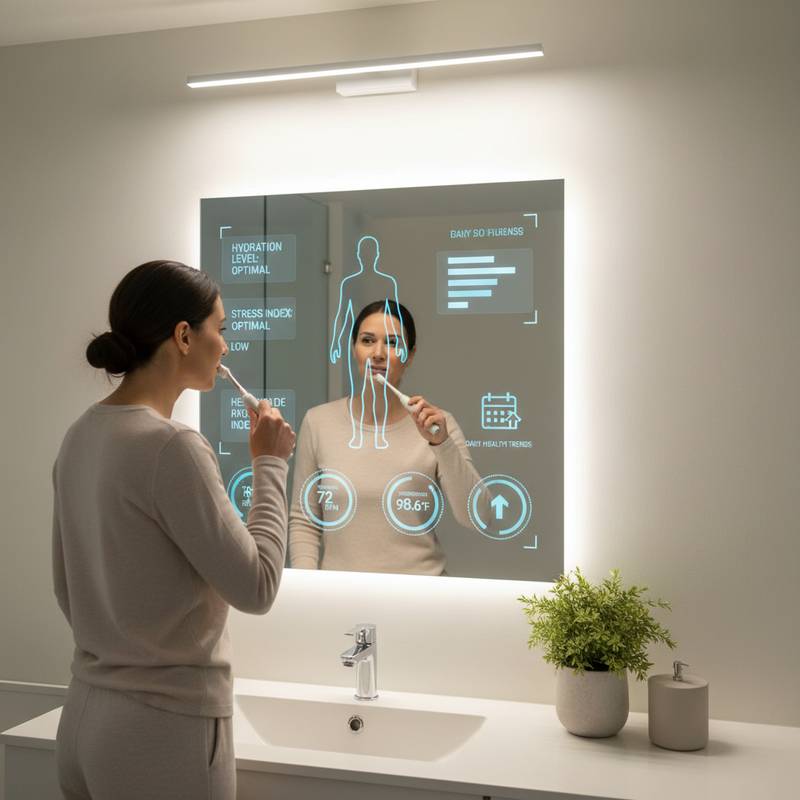Envision a Mirror That Monitors Your Well-Being
You enter the bathroom, and the lighting adjusts to a comfortable level. Your reflection appears in a modern mirror that conceals advanced technology. Embedded sensors evaluate skin tone, hydration, heart rate, and facial expressions as you brush your teeth.
By the time you finish, the mirror provides data on sleep quality, hydration status, and stress compared to previous days. This technology represents the reality of smart mirrors today. Available and increasingly accessible, these devices convert bathrooms into centers for personal health monitoring, comparable to wearable trackers or apps.
The Advantage of Passive Health Monitoring
Individuals often seek better health management, yet tasks like wearing devices or analyzing data add burdens. A smart mirror removes these obstacles by capturing metrics during existing routines. This approach integrates wellness tools effortlessly into daily life.
The benefit stems from its integration into familiar habits. No new behaviors or interfaces require mastery. The device gathers data silently and delivers practical recommendations.
Technology Behind Smart Mirrors
Smart mirrors employ sensors, cameras, and occasionally infrared or radar components to measure biometric information in real time. Metrics include heart rate, breathing rate, skin temperature, and oxygen levels. Machine learning processes this data to identify patterns like fatigue, dehydration, or stress indicators.
These systems link to applications or platforms for data storage and display. Integration with established health services provides a comprehensive view of well-being. Advanced models feature LED illumination mimicking sunlight, voice activation with assistants, and gesture controls for ease.
Guide to Setting Up a Smart Health Mirror
Consider these steps to incorporate a smart mirror into your space.
1. Identify Your Objectives
Determine specific needs, such as basic tracking or comprehensive diagnostics. This choice guides model selection and investment.
2. Select Optimal Location
Bathrooms offer prime placement for routine access, though bedrooms or gyms suit alternatives. Ensure even lighting and reliable power.
3. Pick a Suitable Model
Options differ by capabilities and cost.
-
Affordable Pick: HiMirror Slide (approximately $120)
This portable unit emphasizes skin evaluation, detecting dryness, wrinkles, and pigmentation. It suggests tailored skincare routines. -
Intermediate Option: CareOS Themis (approximately $800)
Designed for bathrooms, it includes lighting, voice features, and user profiles. The device monitors vitals, shows schedules, and connects with scales or oral care tools. -
High-End Choice: Capstone Connected Smart Mirror (approximately $1,200)
Featuring a touch interface with app support, it links to wearables and enables calls. It offers biometric data, posture checks, and media functions.
4. Ensure System Compatibility
Verify alignment with tools like Apple Health or Google Fit before purchase. Seamless connections centralize data for better analysis.
5. Adjust for Precision
Post-installation, calibrate over several days per guidelines. Optimize lighting, positioning, and recognition for reliable results.
6. Monitor Insights Consistently
Maximize value through regular reviews. Examine trends in vitals, skin, or hydration weekly. Persistent shifts may signal needs for further evaluation.
Key Insights from Extensive Testing
After evaluating numerous models, certain aspects stand out beyond promotional claims.
Lighting uniformity proves critical; variations skew sensor outputs. Opt for units with integrated daylight LEDs and consistent bulb types.
Prioritize devices offering on-device data storage. Local processing enhances privacy over cloud reliance, with encryption options in premium versions.
These elements elevate a device from gimmick to dependable health aid.
Core Components of the Technology
Understanding internals reveals capabilities.
- Optical Sensors: Analyze skin hues for heart rate and circulation estimates.
- Thermal Sensors: Gauge temperature to spot inflammation or exhaustion.
- Microphones: Record breaths and vocal tones linked to stress or breathing concerns.
- **Cameras with ** Assess features, stance, and expressions for emotional and mood tracking.
Connectivity via Wi-Fi or Bluetooth transmits information. Premium devices use onboard processing to minimize delays and bolster security.
Essential Practical Factors
Financial Planning
Prices span $150 to thousands based on specifications. Bathroom setups typically cost $500 to $1,500, including installation. Replacements may require structural or electrical modifications.
Setup and Protection
Use GFCI outlets for bathroom connections to mitigate risks. Engage certified professionals for large installations.
Upkeep
Clean surfaces with soft cloths and mild solutions. Avoid direct liquids, and update software via apps.
Data Protection
Secure biometric tools with robust credentials and multi-step verification. Examine sharing settings; trusted makers detail data practices.
Linking to Smart Home Networks
Position the mirror as a wellness hub by connecting to scales, bands, or purifiers. It can alert for hydration needs or recommend exercises based on posture.
Compatible with Google Home, Alexa, or HomeKit, voice prompts display reports or initiate sequences. Automated responses adjust environments to biometric cues.
Advancing Preventive Wellness
These mirrors contribute to early detection in health technology. Subtle metric changes encourage timely actions, like consulting professionals on anomalies.
Serving as routine assessments, they connect personal observations to expert care. Though not substitutes for clinical tools, they act as initial alerts.
Forward-Looking Developments
Innovations include non-contact radar for vitals and optical blood analysis. Prototypes explore microbiome evaluation.
Costs decline with scale, broadening access. Integrations with telehealth promise clinician reviews of data.
The vision centers on comprehensive, low-effort health oversight.
Key Terms
- Biometric Data: Traits like heart rate or facial traits for identification or tracking.
- Edge Computing: Local data handling on the device, independent of clouds.
- Infrared Sensor: Detects thermal energy for temperature assessment.
- GFCI: Safety mechanism interrupting circuits in moist settings.
Steps to Implement Effectively
Test with a small unit alongside current apps to gauge utility. Upgrade if beneficial to full integrations.
For permanent setups, source skilled installers through reliable services. Proper execution guarantees safety and functionality.
